Teaching, Learning and Assessment in Educational and Training
VerifiedAdded on 2023/06/08
|8
|1917
|180
AI Summary
This content discusses the roles and responsibilities of a teacher, individual learning requirements, assessment methods, and inclusive teaching practices in education and training. It covers topics such as initial assessment, diagnostic assessment, minimum core elements, and resources for meeting the learning needs of students. The content also provides suggestions for improving teaching practices and updating professional qualifications. The subject is relevant to anyone interested in education and training, and the content is available on Desklib, an online library for study material with solved assignments, essays, and dissertations.
Contribute Materials
Your contribution can guide someone’s learning journey. Share your
documents today.
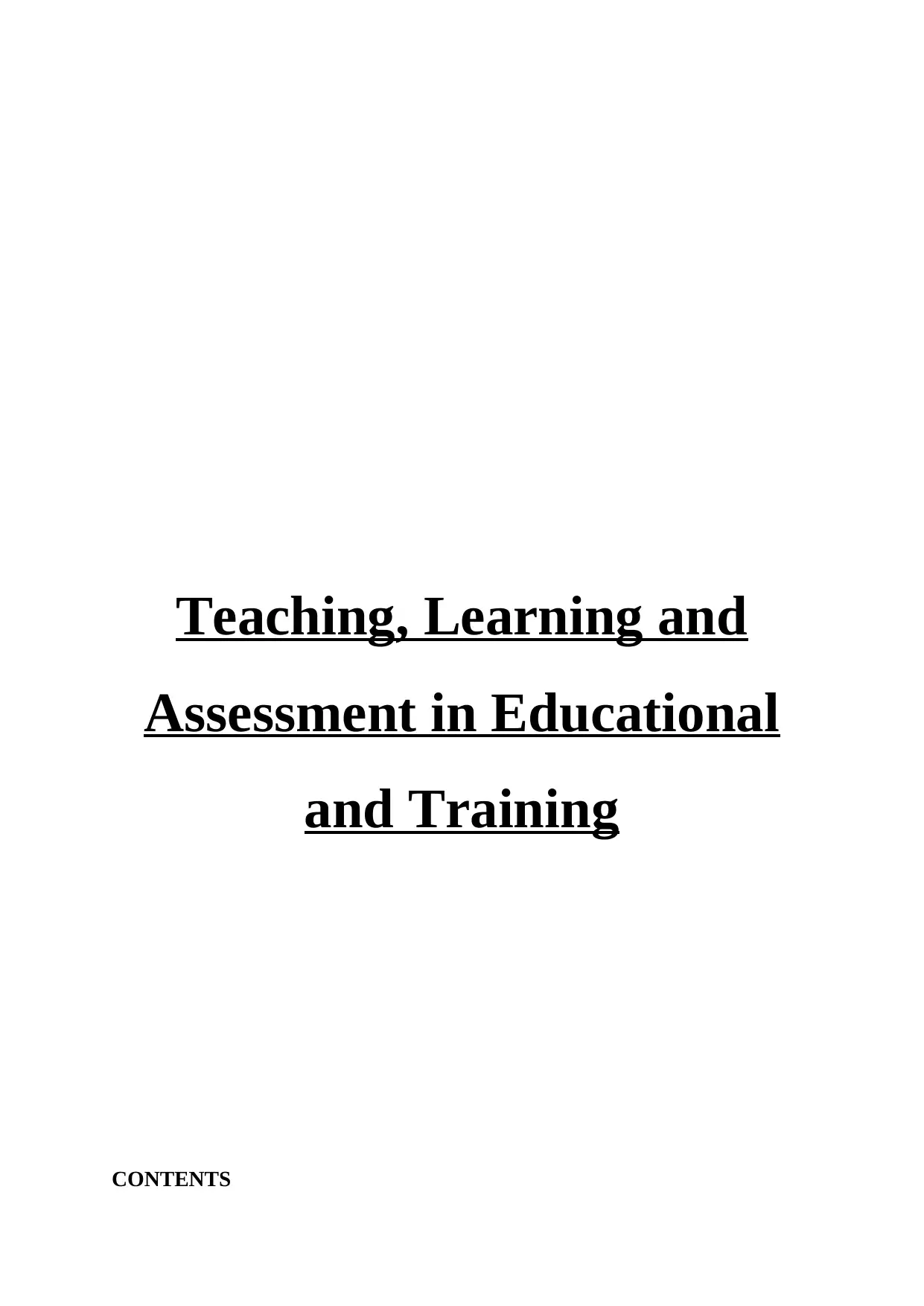
Teaching, Learning and
Assessment in Educational
and Training
CONTENTS
Assessment in Educational
and Training
CONTENTS
Secure Best Marks with AI Grader
Need help grading? Try our AI Grader for instant feedback on your assignments.
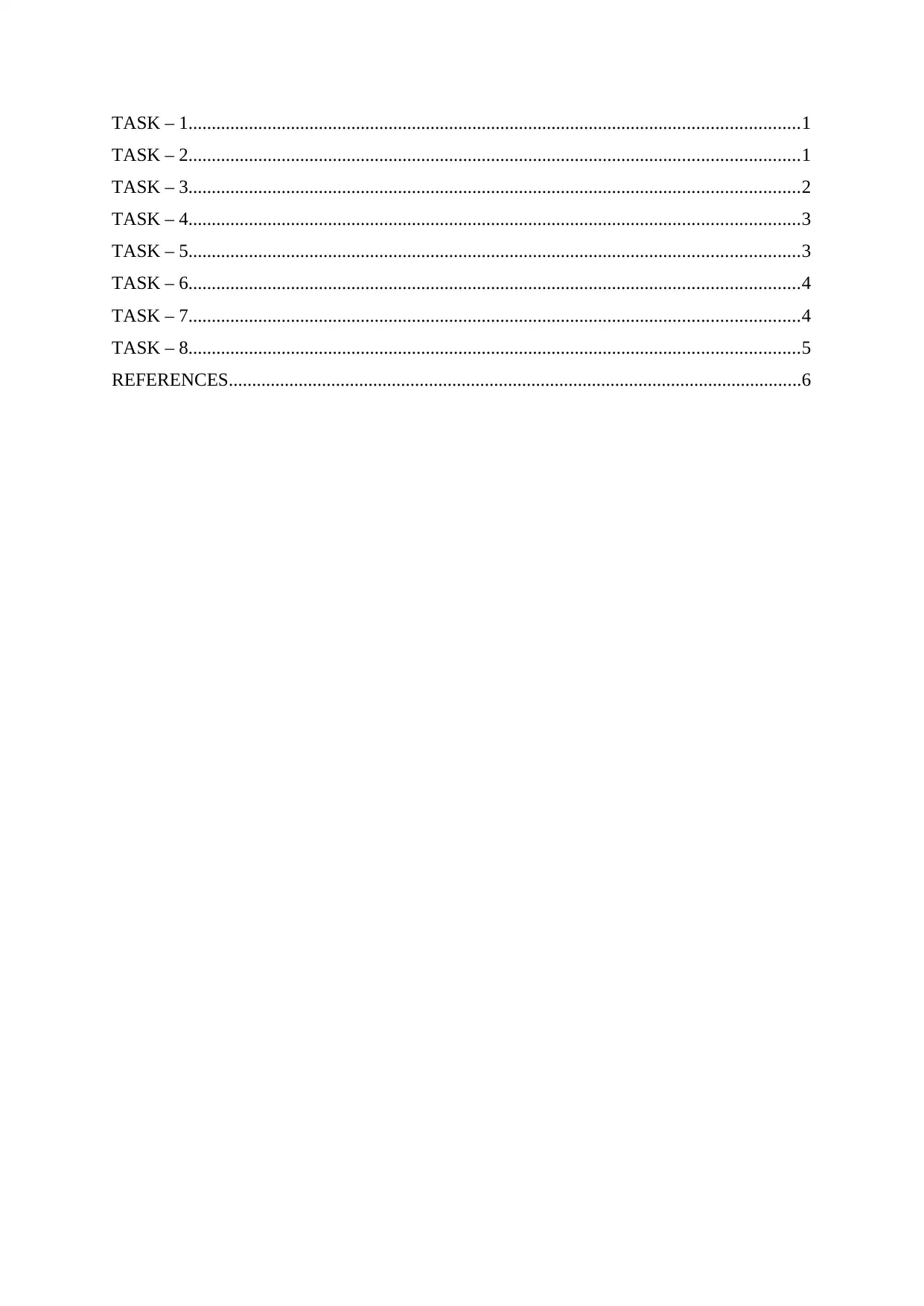
TASK – 1...................................................................................................................................1
TASK – 2...................................................................................................................................1
TASK – 3...................................................................................................................................2
TASK – 4...................................................................................................................................3
TASK – 5...................................................................................................................................3
TASK – 6...................................................................................................................................4
TASK – 7...................................................................................................................................4
TASK – 8...................................................................................................................................5
REFERENCES...........................................................................................................................6
TASK – 2...................................................................................................................................1
TASK – 3...................................................................................................................................2
TASK – 4...................................................................................................................................3
TASK – 5...................................................................................................................................3
TASK – 6...................................................................................................................................4
TASK – 7...................................................................................................................................4
TASK – 8...................................................................................................................................5
REFERENCES...........................................................................................................................6
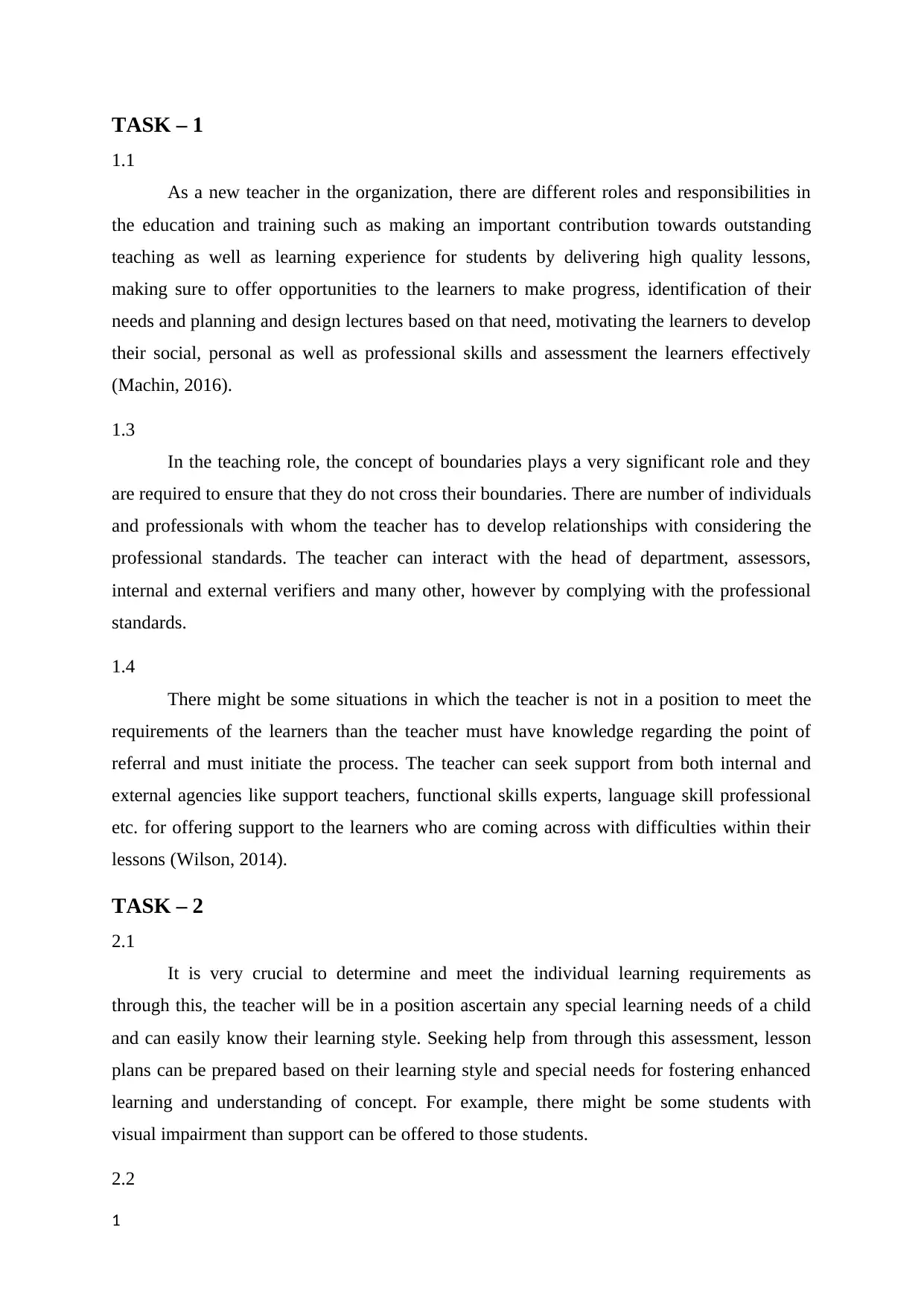
TASK – 1
1.1
As a new teacher in the organization, there are different roles and responsibilities in
the education and training such as making an important contribution towards outstanding
teaching as well as learning experience for students by delivering high quality lessons,
making sure to offer opportunities to the learners to make progress, identification of their
needs and planning and design lectures based on that need, motivating the learners to develop
their social, personal as well as professional skills and assessment the learners effectively
(Machin, 2016).
1.3
In the teaching role, the concept of boundaries plays a very significant role and they
are required to ensure that they do not cross their boundaries. There are number of individuals
and professionals with whom the teacher has to develop relationships with considering the
professional standards. The teacher can interact with the head of department, assessors,
internal and external verifiers and many other, however by complying with the professional
standards.
1.4
There might be some situations in which the teacher is not in a position to meet the
requirements of the learners than the teacher must have knowledge regarding the point of
referral and must initiate the process. The teacher can seek support from both internal and
external agencies like support teachers, functional skills experts, language skill professional
etc. for offering support to the learners who are coming across with difficulties within their
lessons (Wilson, 2014).
TASK – 2
2.1
It is very crucial to determine and meet the individual learning requirements as
through this, the teacher will be in a position ascertain any special learning needs of a child
and can easily know their learning style. Seeking help from through this assessment, lesson
plans can be prepared based on their learning style and special needs for fostering enhanced
learning and understanding of concept. For example, there might be some students with
visual impairment than support can be offered to those students.
2.2
1
1.1
As a new teacher in the organization, there are different roles and responsibilities in
the education and training such as making an important contribution towards outstanding
teaching as well as learning experience for students by delivering high quality lessons,
making sure to offer opportunities to the learners to make progress, identification of their
needs and planning and design lectures based on that need, motivating the learners to develop
their social, personal as well as professional skills and assessment the learners effectively
(Machin, 2016).
1.3
In the teaching role, the concept of boundaries plays a very significant role and they
are required to ensure that they do not cross their boundaries. There are number of individuals
and professionals with whom the teacher has to develop relationships with considering the
professional standards. The teacher can interact with the head of department, assessors,
internal and external verifiers and many other, however by complying with the professional
standards.
1.4
There might be some situations in which the teacher is not in a position to meet the
requirements of the learners than the teacher must have knowledge regarding the point of
referral and must initiate the process. The teacher can seek support from both internal and
external agencies like support teachers, functional skills experts, language skill professional
etc. for offering support to the learners who are coming across with difficulties within their
lessons (Wilson, 2014).
TASK – 2
2.1
It is very crucial to determine and meet the individual learning requirements as
through this, the teacher will be in a position ascertain any special learning needs of a child
and can easily know their learning style. Seeking help from through this assessment, lesson
plans can be prepared based on their learning style and special needs for fostering enhanced
learning and understanding of concept. For example, there might be some students with
visual impairment than support can be offered to those students.
2.2
1
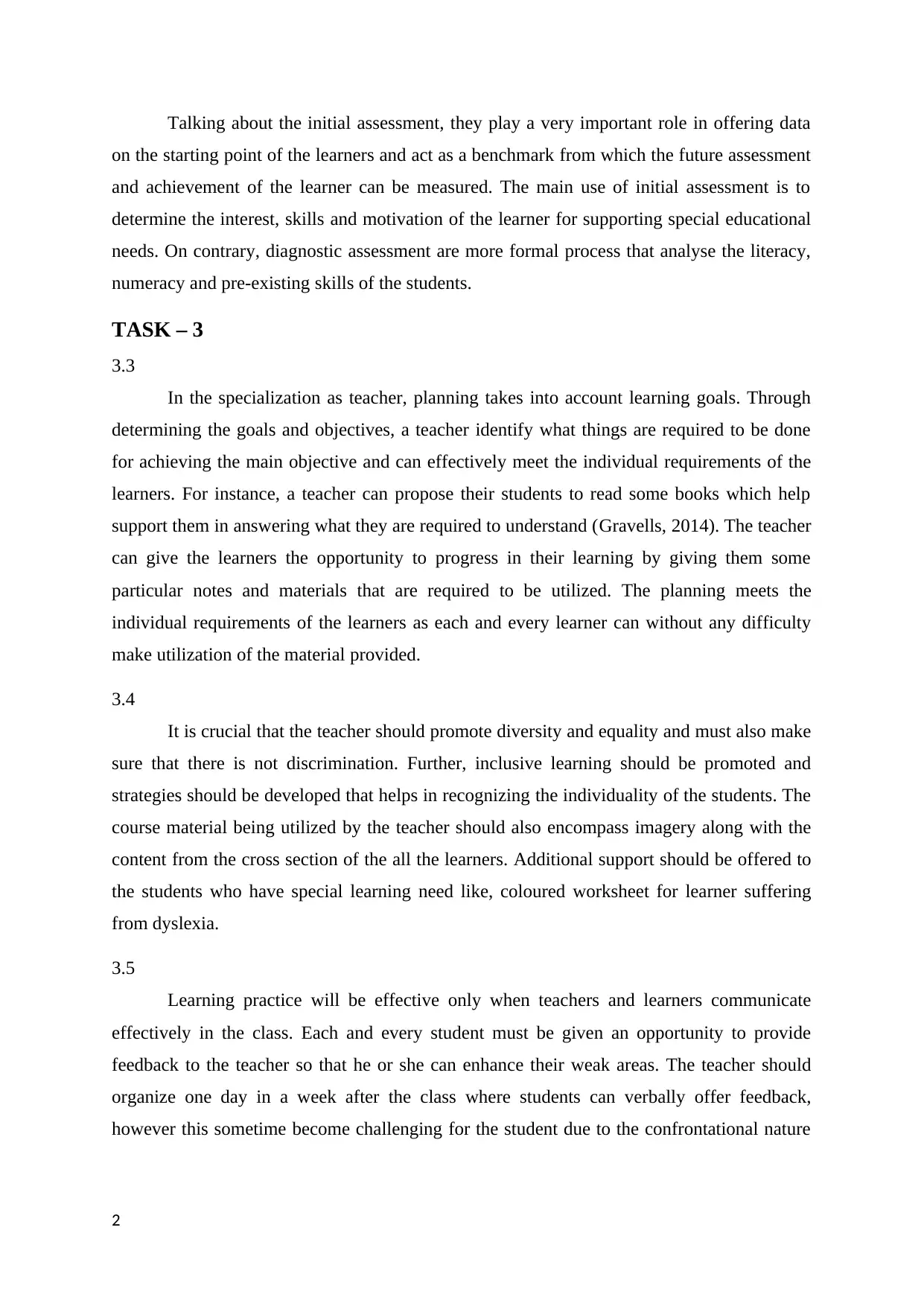
Talking about the initial assessment, they play a very important role in offering data
on the starting point of the learners and act as a benchmark from which the future assessment
and achievement of the learner can be measured. The main use of initial assessment is to
determine the interest, skills and motivation of the learner for supporting special educational
needs. On contrary, diagnostic assessment are more formal process that analyse the literacy,
numeracy and pre-existing skills of the students.
TASK – 3
3.3
In the specialization as teacher, planning takes into account learning goals. Through
determining the goals and objectives, a teacher identify what things are required to be done
for achieving the main objective and can effectively meet the individual requirements of the
learners. For instance, a teacher can propose their students to read some books which help
support them in answering what they are required to understand (Gravells, 2014). The teacher
can give the learners the opportunity to progress in their learning by giving them some
particular notes and materials that are required to be utilized. The planning meets the
individual requirements of the learners as each and every learner can without any difficulty
make utilization of the material provided.
3.4
It is crucial that the teacher should promote diversity and equality and must also make
sure that there is not discrimination. Further, inclusive learning should be promoted and
strategies should be developed that helps in recognizing the individuality of the students. The
course material being utilized by the teacher should also encompass imagery along with the
content from the cross section of the all the learners. Additional support should be offered to
the students who have special learning need like, coloured worksheet for learner suffering
from dyslexia.
3.5
Learning practice will be effective only when teachers and learners communicate
effectively in the class. Each and every student must be given an opportunity to provide
feedback to the teacher so that he or she can enhance their weak areas. The teacher should
organize one day in a week after the class where students can verbally offer feedback,
however this sometime become challenging for the student due to the confrontational nature
2
on the starting point of the learners and act as a benchmark from which the future assessment
and achievement of the learner can be measured. The main use of initial assessment is to
determine the interest, skills and motivation of the learner for supporting special educational
needs. On contrary, diagnostic assessment are more formal process that analyse the literacy,
numeracy and pre-existing skills of the students.
TASK – 3
3.3
In the specialization as teacher, planning takes into account learning goals. Through
determining the goals and objectives, a teacher identify what things are required to be done
for achieving the main objective and can effectively meet the individual requirements of the
learners. For instance, a teacher can propose their students to read some books which help
support them in answering what they are required to understand (Gravells, 2014). The teacher
can give the learners the opportunity to progress in their learning by giving them some
particular notes and materials that are required to be utilized. The planning meets the
individual requirements of the learners as each and every learner can without any difficulty
make utilization of the material provided.
3.4
It is crucial that the teacher should promote diversity and equality and must also make
sure that there is not discrimination. Further, inclusive learning should be promoted and
strategies should be developed that helps in recognizing the individuality of the students. The
course material being utilized by the teacher should also encompass imagery along with the
content from the cross section of the all the learners. Additional support should be offered to
the students who have special learning need like, coloured worksheet for learner suffering
from dyslexia.
3.5
Learning practice will be effective only when teachers and learners communicate
effectively in the class. Each and every student must be given an opportunity to provide
feedback to the teacher so that he or she can enhance their weak areas. The teacher should
organize one day in a week after the class where students can verbally offer feedback,
however this sometime become challenging for the student due to the confrontational nature
2
Secure Best Marks with AI Grader
Need help grading? Try our AI Grader for instant feedback on your assignments.
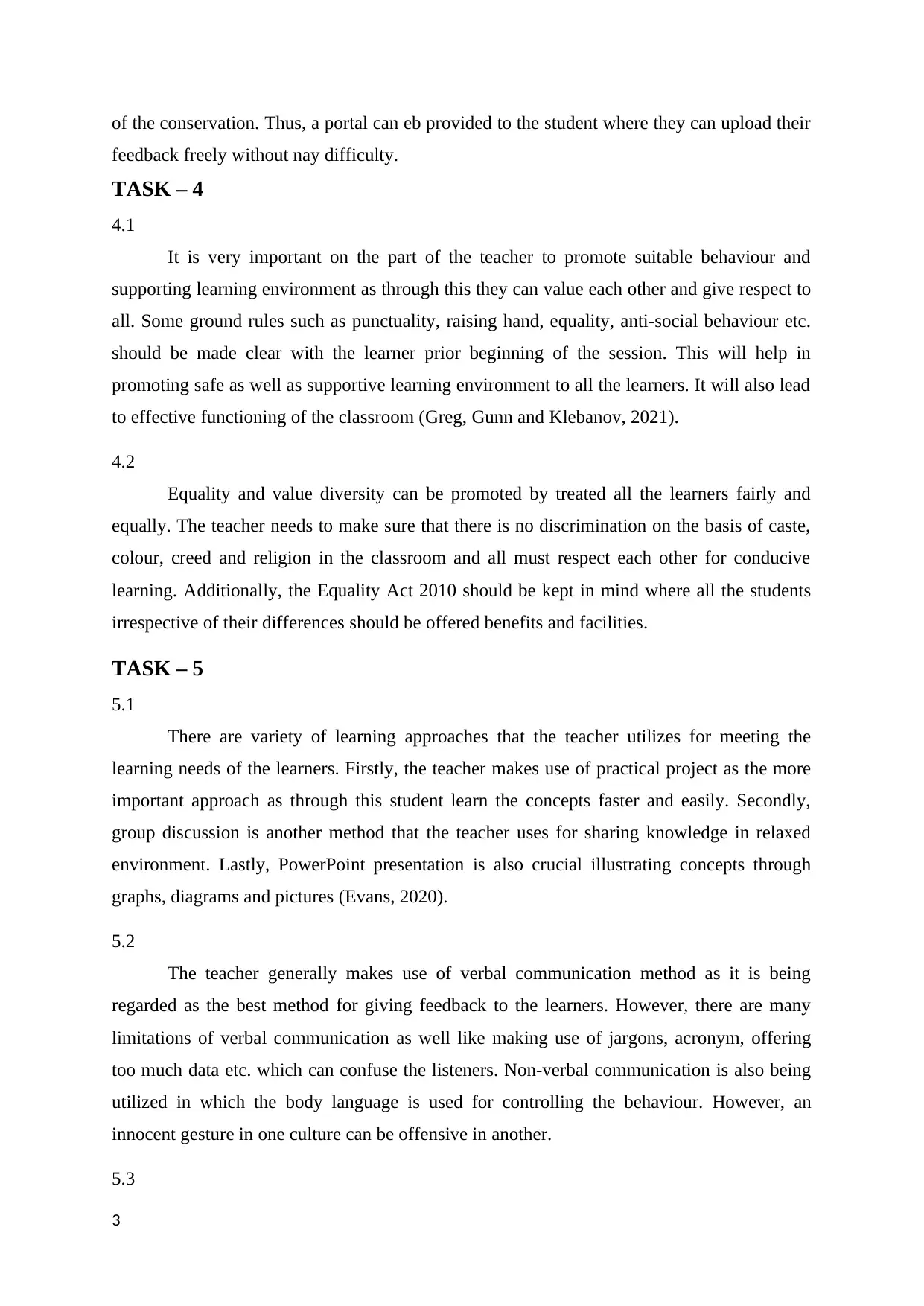
of the conservation. Thus, a portal can eb provided to the student where they can upload their
feedback freely without nay difficulty.
TASK – 4
4.1
It is very important on the part of the teacher to promote suitable behaviour and
supporting learning environment as through this they can value each other and give respect to
all. Some ground rules such as punctuality, raising hand, equality, anti-social behaviour etc.
should be made clear with the learner prior beginning of the session. This will help in
promoting safe as well as supportive learning environment to all the learners. It will also lead
to effective functioning of the classroom (Greg, Gunn and Klebanov, 2021).
4.2
Equality and value diversity can be promoted by treated all the learners fairly and
equally. The teacher needs to make sure that there is no discrimination on the basis of caste,
colour, creed and religion in the classroom and all must respect each other for conducive
learning. Additionally, the Equality Act 2010 should be kept in mind where all the students
irrespective of their differences should be offered benefits and facilities.
TASK – 5
5.1
There are variety of learning approaches that the teacher utilizes for meeting the
learning needs of the learners. Firstly, the teacher makes use of practical project as the more
important approach as through this student learn the concepts faster and easily. Secondly,
group discussion is another method that the teacher uses for sharing knowledge in relaxed
environment. Lastly, PowerPoint presentation is also crucial illustrating concepts through
graphs, diagrams and pictures (Evans, 2020).
5.2
The teacher generally makes use of verbal communication method as it is being
regarded as the best method for giving feedback to the learners. However, there are many
limitations of verbal communication as well like making use of jargons, acronym, offering
too much data etc. which can confuse the listeners. Non-verbal communication is also being
utilized in which the body language is used for controlling the behaviour. However, an
innocent gesture in one culture can be offensive in another.
5.3
3
feedback freely without nay difficulty.
TASK – 4
4.1
It is very important on the part of the teacher to promote suitable behaviour and
supporting learning environment as through this they can value each other and give respect to
all. Some ground rules such as punctuality, raising hand, equality, anti-social behaviour etc.
should be made clear with the learner prior beginning of the session. This will help in
promoting safe as well as supportive learning environment to all the learners. It will also lead
to effective functioning of the classroom (Greg, Gunn and Klebanov, 2021).
4.2
Equality and value diversity can be promoted by treated all the learners fairly and
equally. The teacher needs to make sure that there is no discrimination on the basis of caste,
colour, creed and religion in the classroom and all must respect each other for conducive
learning. Additionally, the Equality Act 2010 should be kept in mind where all the students
irrespective of their differences should be offered benefits and facilities.
TASK – 5
5.1
There are variety of learning approaches that the teacher utilizes for meeting the
learning needs of the learners. Firstly, the teacher makes use of practical project as the more
important approach as through this student learn the concepts faster and easily. Secondly,
group discussion is another method that the teacher uses for sharing knowledge in relaxed
environment. Lastly, PowerPoint presentation is also crucial illustrating concepts through
graphs, diagrams and pictures (Evans, 2020).
5.2
The teacher generally makes use of verbal communication method as it is being
regarded as the best method for giving feedback to the learners. However, there are many
limitations of verbal communication as well like making use of jargons, acronym, offering
too much data etc. which can confuse the listeners. Non-verbal communication is also being
utilized in which the body language is used for controlling the behaviour. However, an
innocent gesture in one culture can be offensive in another.
5.3
3
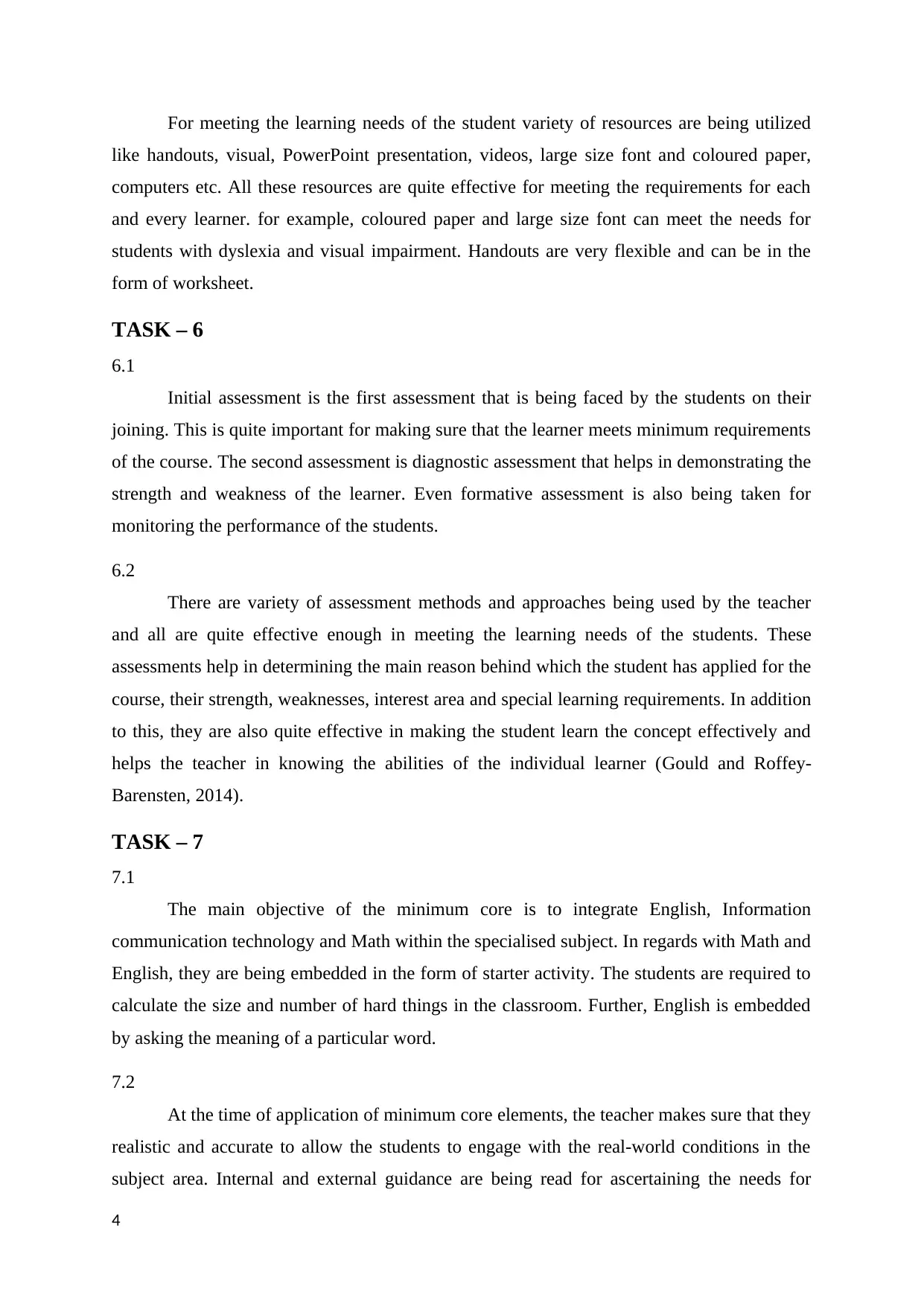
For meeting the learning needs of the student variety of resources are being utilized
like handouts, visual, PowerPoint presentation, videos, large size font and coloured paper,
computers etc. All these resources are quite effective for meeting the requirements for each
and every learner. for example, coloured paper and large size font can meet the needs for
students with dyslexia and visual impairment. Handouts are very flexible and can be in the
form of worksheet.
TASK – 6
6.1
Initial assessment is the first assessment that is being faced by the students on their
joining. This is quite important for making sure that the learner meets minimum requirements
of the course. The second assessment is diagnostic assessment that helps in demonstrating the
strength and weakness of the learner. Even formative assessment is also being taken for
monitoring the performance of the students.
6.2
There are variety of assessment methods and approaches being used by the teacher
and all are quite effective enough in meeting the learning needs of the students. These
assessments help in determining the main reason behind which the student has applied for the
course, their strength, weaknesses, interest area and special learning requirements. In addition
to this, they are also quite effective in making the student learn the concept effectively and
helps the teacher in knowing the abilities of the individual learner (Gould and Roffey-
Barensten, 2014).
TASK – 7
7.1
The main objective of the minimum core is to integrate English, Information
communication technology and Math within the specialised subject. In regards with Math and
English, they are being embedded in the form of starter activity. The students are required to
calculate the size and number of hard things in the classroom. Further, English is embedded
by asking the meaning of a particular word.
7.2
At the time of application of minimum core elements, the teacher makes sure that they
realistic and accurate to allow the students to engage with the real-world conditions in the
subject area. Internal and external guidance are being read for ascertaining the needs for
4
like handouts, visual, PowerPoint presentation, videos, large size font and coloured paper,
computers etc. All these resources are quite effective for meeting the requirements for each
and every learner. for example, coloured paper and large size font can meet the needs for
students with dyslexia and visual impairment. Handouts are very flexible and can be in the
form of worksheet.
TASK – 6
6.1
Initial assessment is the first assessment that is being faced by the students on their
joining. This is quite important for making sure that the learner meets minimum requirements
of the course. The second assessment is diagnostic assessment that helps in demonstrating the
strength and weakness of the learner. Even formative assessment is also being taken for
monitoring the performance of the students.
6.2
There are variety of assessment methods and approaches being used by the teacher
and all are quite effective enough in meeting the learning needs of the students. These
assessments help in determining the main reason behind which the student has applied for the
course, their strength, weaknesses, interest area and special learning requirements. In addition
to this, they are also quite effective in making the student learn the concept effectively and
helps the teacher in knowing the abilities of the individual learner (Gould and Roffey-
Barensten, 2014).
TASK – 7
7.1
The main objective of the minimum core is to integrate English, Information
communication technology and Math within the specialised subject. In regards with Math and
English, they are being embedded in the form of starter activity. The students are required to
calculate the size and number of hard things in the classroom. Further, English is embedded
by asking the meaning of a particular word.
7.2
At the time of application of minimum core elements, the teacher makes sure that they
realistic and accurate to allow the students to engage with the real-world conditions in the
subject area. Internal and external guidance are being read for ascertaining the needs for
4
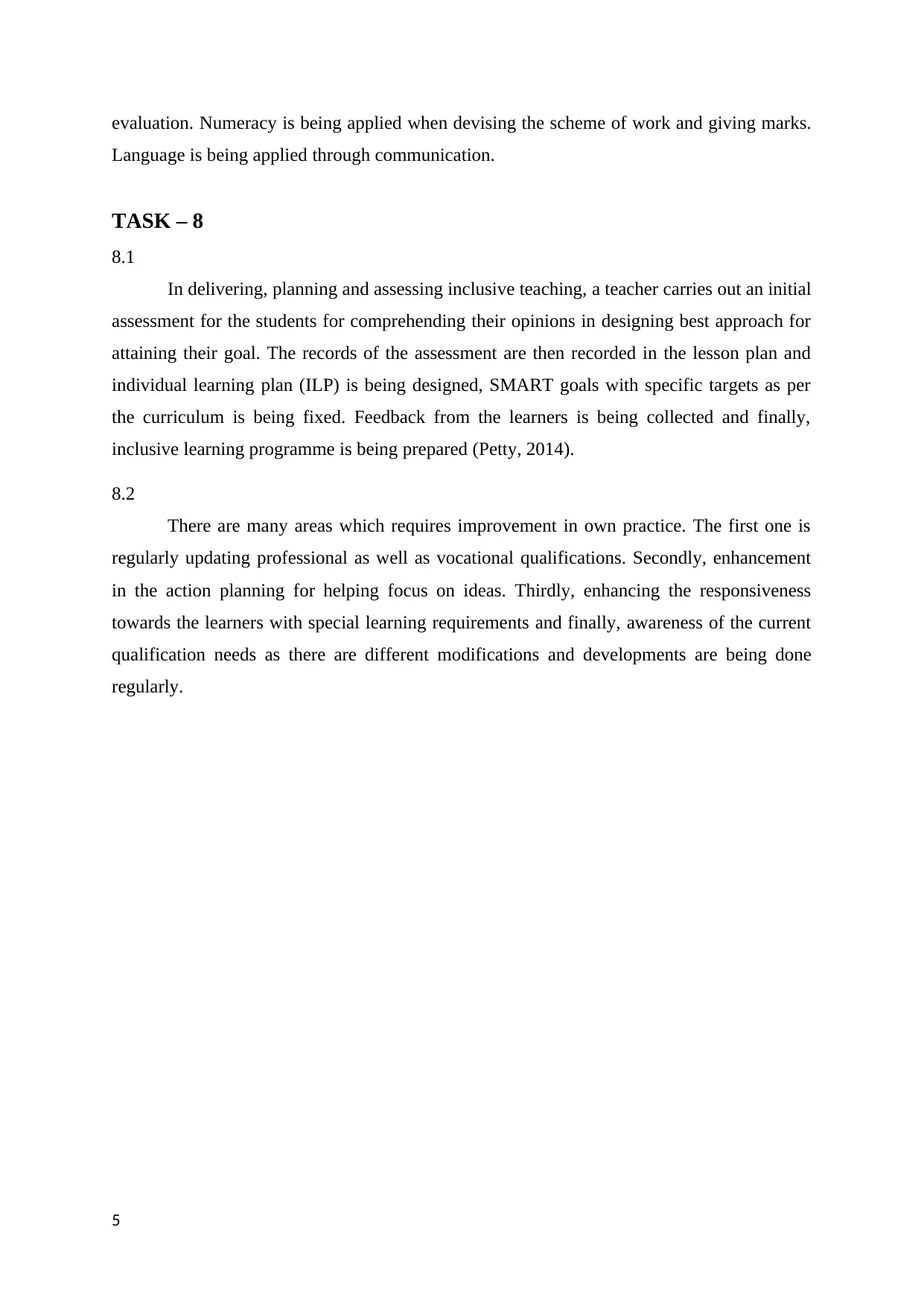
evaluation. Numeracy is being applied when devising the scheme of work and giving marks.
Language is being applied through communication.
TASK – 8
8.1
In delivering, planning and assessing inclusive teaching, a teacher carries out an initial
assessment for the students for comprehending their opinions in designing best approach for
attaining their goal. The records of the assessment are then recorded in the lesson plan and
individual learning plan (ILP) is being designed, SMART goals with specific targets as per
the curriculum is being fixed. Feedback from the learners is being collected and finally,
inclusive learning programme is being prepared (Petty, 2014).
8.2
There are many areas which requires improvement in own practice. The first one is
regularly updating professional as well as vocational qualifications. Secondly, enhancement
in the action planning for helping focus on ideas. Thirdly, enhancing the responsiveness
towards the learners with special learning requirements and finally, awareness of the current
qualification needs as there are different modifications and developments are being done
regularly.
5
Language is being applied through communication.
TASK – 8
8.1
In delivering, planning and assessing inclusive teaching, a teacher carries out an initial
assessment for the students for comprehending their opinions in designing best approach for
attaining their goal. The records of the assessment are then recorded in the lesson plan and
individual learning plan (ILP) is being designed, SMART goals with specific targets as per
the curriculum is being fixed. Feedback from the learners is being collected and finally,
inclusive learning programme is being prepared (Petty, 2014).
8.2
There are many areas which requires improvement in own practice. The first one is
regularly updating professional as well as vocational qualifications. Secondly, enhancement
in the action planning for helping focus on ideas. Thirdly, enhancing the responsiveness
towards the learners with special learning requirements and finally, awareness of the current
qualification needs as there are different modifications and developments are being done
regularly.
5
Paraphrase This Document
Need a fresh take? Get an instant paraphrase of this document with our AI Paraphraser
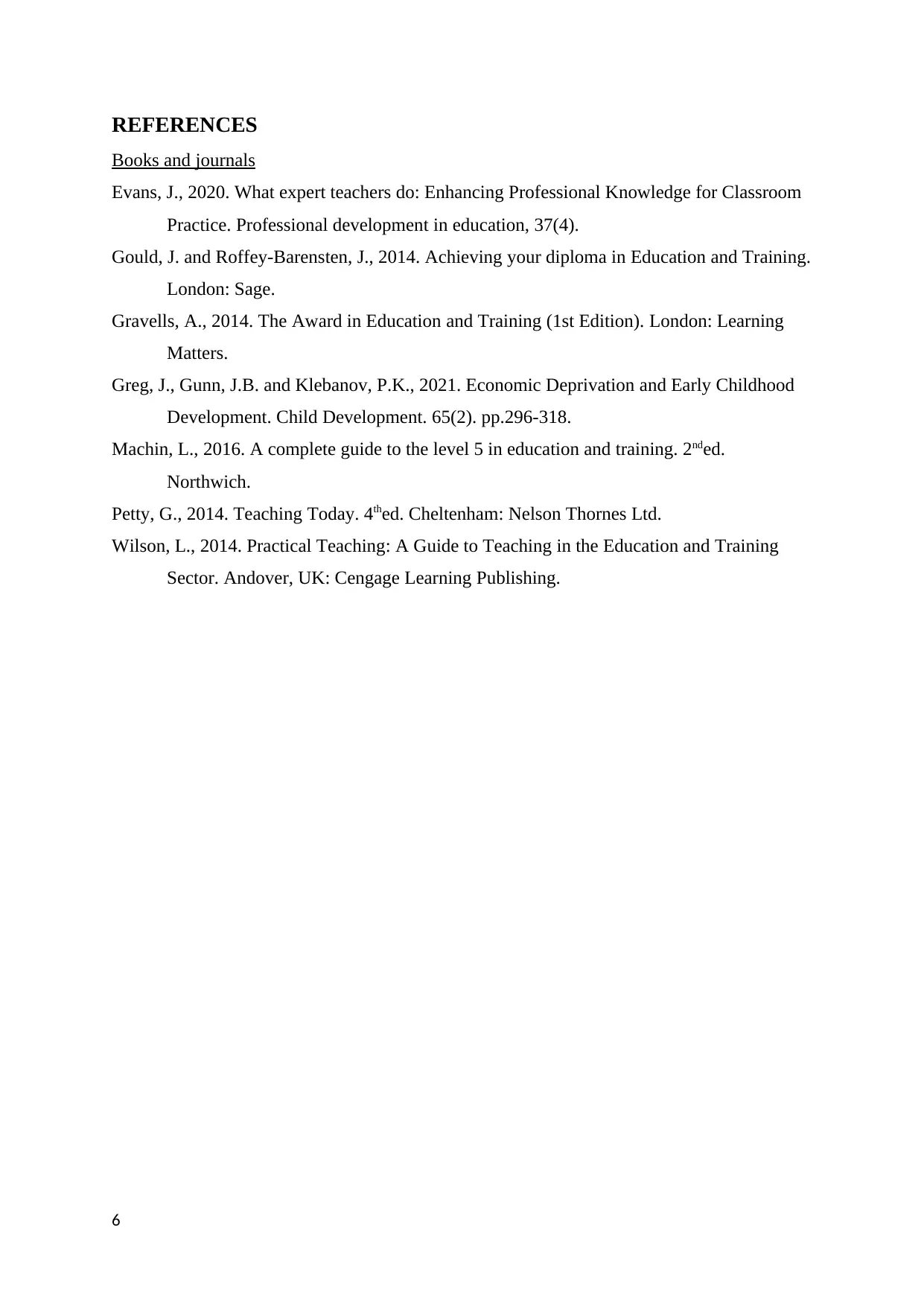
REFERENCES
Books and journals
Evans, J., 2020. What expert teachers do: Enhancing Professional Knowledge for Classroom
Practice. Professional development in education, 37(4).
Gould, J. and Roffey-Barensten, J., 2014. Achieving your diploma in Education and Training.
London: Sage.
Gravells, A., 2014. The Award in Education and Training (1st Edition). London: Learning
Matters.
Greg, J., Gunn, J.B. and Klebanov, P.K., 2021. Economic Deprivation and Early Childhood
Development. Child Development. 65(2). pp.296-318.
Machin, L., 2016. A complete guide to the level 5 in education and training. 2nded.
Northwich.
Petty, G., 2014. Teaching Today. 4thed. Cheltenham: Nelson Thornes Ltd.
Wilson, L., 2014. Practical Teaching: A Guide to Teaching in the Education and Training
Sector. Andover, UK: Cengage Learning Publishing.
6
Books and journals
Evans, J., 2020. What expert teachers do: Enhancing Professional Knowledge for Classroom
Practice. Professional development in education, 37(4).
Gould, J. and Roffey-Barensten, J., 2014. Achieving your diploma in Education and Training.
London: Sage.
Gravells, A., 2014. The Award in Education and Training (1st Edition). London: Learning
Matters.
Greg, J., Gunn, J.B. and Klebanov, P.K., 2021. Economic Deprivation and Early Childhood
Development. Child Development. 65(2). pp.296-318.
Machin, L., 2016. A complete guide to the level 5 in education and training. 2nded.
Northwich.
Petty, G., 2014. Teaching Today. 4thed. Cheltenham: Nelson Thornes Ltd.
Wilson, L., 2014. Practical Teaching: A Guide to Teaching in the Education and Training
Sector. Andover, UK: Cengage Learning Publishing.
6
1 out of 8
Related Documents
Your All-in-One AI-Powered Toolkit for Academic Success.
+13062052269
info@desklib.com
Available 24*7 on WhatsApp / Email
![[object Object]](/_next/static/media/star-bottom.7253800d.svg)
Unlock your academic potential
© 2024 | Zucol Services PVT LTD | All rights reserved.




